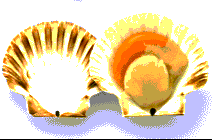Scallops are swimming bivalves. They do not swim very often or very well,but they can clap their shells together sharply, forcing jets of water out which propel them in any direction they wish. As they are heavy, they tend to sink down quickly and cannot rise more than a meter or so above the surface of the mud where they live.

Most of the shellfish which move actively pull themselves along the ground by the foot. The scallops get their power from the muscles which join the two valves of the shells together. In the creeping bivalves these muscles are relatively small, but in the scallops they have so much more work to do that they account for most of the meat of the animal.
Unlike oysters and mussels and the most of the other bivalves, the scallops
Has eyes, a large number of tiny black ones on the outer edge of the body. When one sees a starfish approaching, it very often succeeds in swimming off to a safe place , leaving the slow moving starfish to search for another victim. The most important member of the group is thee escallop or great scallop. It usually lives off shores in rather deep water on sandy or sometimes on muddy ground. It differs from the others in having one valve curved and the other flat. By squirting water downwards through the sand and by the rocking backwards and forwards the escallop make a hollow in the mud. It fits the rounded part of the shell neatly in this and the flat valve lies level with the surface. Escallops have a long spawning season, from April to October. The spat settle on clear ground and attach themselves to some solid anchorage by byssus threads. When the shells have grown to the size of a thumb nail, the byssus is lost and the escallops is free to swim if it wants to.
It is a filter feeder and therefore usually contend to stay on the sea bed. Escallops are very good to eat. Those that live in shallow water are caught with long handles nets. Scallops shells have an unmistakable shape. They or more less circular, with ribs radiating from near the hinge. At the hinge, the shell is extended in to a pair of ears. In some species the ears are roughly equal in size, but in others one is much bigger than the other. Beside the escallop, two of the best known species are the queen and the clusheen.
The queen is smaller than the escallop and both valves of the shell are curved. The front ear of the clusheen is two or three times longerthan the queen, with a length of up to six centimeters.
